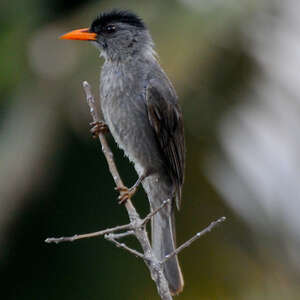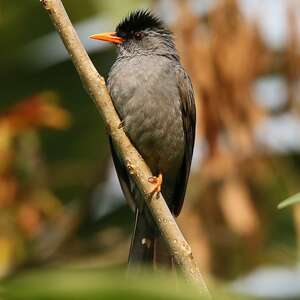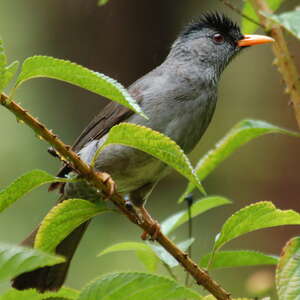Malagasy Bulbul
Hypsipetes madagascariensis - Bulbul de Madagascar
Identification
The Malagasy Bulbul is a bird slightly smaller than the Blackbird. There is no sexual dimorphism. It is in the average size of other bulbuls. The chin, the crown and the forehead are black. The body is entirely dark grey on the top and grey ash on the bottom. The beak is bright orange and the legs are yellow. It has a magnificent vivid red iris that one cannot forget. The feathers of the head are bristled giving it a small stern side. The juvenile is duller and its iris is darker.
Subspecific information 3 subspecies
- Hypsipetes madagascariensis madagascariensis (Madagascar and Comoro Is.)
- Hypsipetes madagascariensis grotei (Glorioso Is.)
- Hypsipetes madagascariensis rostratus (Aldabra Is.)
Foreign names
- Bulbul de Madagascar,
- Bulbul malgache,
- bulbul-malgaxe,
- Madagaskar-Rotschnabelbülbül,
- madagaszkári bülbül,
- Zwarte Buulbuul,
- Bulbul del Madagascar,
- madagaskarbulbyl,
- Madagaskarbylbyl,
- bylbyl horovana,
- bulbulčík ostrovní,
- Madagaskarbulbul,
- mustabulbuli,
- bulbul fumat de Madagascar,
- szczeciak ciemny,
- Мадагаскарский восточный бюльбюль,
- クロヒヨドリ,
- 马岛短脚鹎,
- madagaskarbulbyl,
- 馬達加斯加黑短腳鵯,
Habitat
Behaviour character trait
Dietfeeding habits
Reproduction nesting
Geographic range
Threats - protection
Sources of information
- IOC World Bird List (v15.1), Gill, F and D Donsker (Eds). 2025-12-07.
- Birds of Seychelles, Skerrett Adrian, Bullock Ian, Disley Tony
- Les Oiseaux de Mayotte, Clément Michel, Grissac Philippe, Rolland Robin
- Oiseaux des iles de l'océan Indien, Langrand Olivier, ian Sinclair
Other sources of interest
 Specification sheet created on
25/07/2023 by Nathalie Santa Maria
Specification sheet created on
25/07/2023 by Nathalie Santa MariaTranslation by AI Oiseaux.net
© 1996-2025 Oiseaux.net
- Accipitriformes
- Aegotheliformes
- Anseriformes
- Apodiformes
- Apterygiformes
- Bucerotiformes
- Caprimulgiformes
- Cariamiformes
- Casuariiformes
- Charadriiformes
- Ciconiiformes
- Coliiformes
- Columbiformes
- Coraciiformes
- Cuculiformes
- Eurypygiformes
- Falconiformes
- Galliformes
- Gaviiformes
- Gruiformes
- Leptosomiformes
- Mesitornithiformes
- Musophagiformes
- Nyctibiiformes
- Opisthocomiformes
- Otidiformes
- Passeriformes
- Pelecaniformes
- Phaethontiformes
- Phoenicopteriformes
- Piciformes
- Podargiformes
- Podicipediformes
- Procellariiformes
- Psittaciformes
- Pterocliformes
- Rheiformes
- Sphenisciformes
- Steatornithiformes
- Strigiformes
- Struthioniformes
- Suliformes
- Tinamiformes
- Trogoniformes































